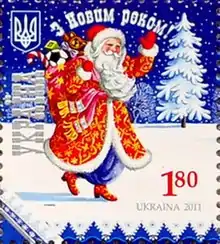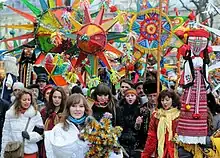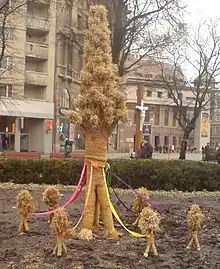Christmas in Ukraine
Traditional Ukrainian Christmas festivities start on Christmas Eve, which is celebrated from December 24 to January 6, the date of the celebration of the baptism of Jesus, known in Ukraine as Vodokhreshche or Yordan,[1] according to the Gregorian calendar and Revised Julian calendar by the Orthodox Church of Ukraine,[2] the Catholic Church (including Latin and Ukrainian Greek Catholics[3]), and most Protestants.
| Christmas in Ukraine | |
|---|---|
 | |
| Also called | Ukrainian: Різдво, Rizdvo |
| Observed by | Christians, many non-Christians |
| Type | Christian, cultural |
| Significance | Commemoration of the nativity of Jesus |
| Celebrations | Gift-giving, family and other social gatherings, symbolic decoration, feasting, etc. |
| Observances | Church services |
| Date |
|
| Frequency | Annual |
| Related to | Nativity Fast |
The Ukrainian Orthodox Church of the Moscow Patriarchate (except for the Romanian parishes[4]), some parishes of the Orthodox Church of Ukraine and Protestant churches celebrate Christmas according to the Julian calendar, so the Gregorian holidays last from January 6 to January 19. The Armenian Diocese of Ukraine of the Armenian Apostolic Church and the Armenian Catholic Church in Ukraine celebrates Christmas from January 5 to January 6 along with Epiphany according to the Gregorian calendar.[5][6]
Christmas was largely erased from the Ukrainian calendar for much of the 20th century due to the Soviet Union's anti-religious policies, but many of its traditions survived and are being revived again.
History
In Ukraine, the Christmas holiday became the official celebration with the baptism of Rus' ordered by Prince Vladimir in the late 10th century. However, given the early Christian community of Kievan Rus', the celebration may have a longer history.

In the 19th century, a lavishly decorated Christmas tree became central to the holiday, a tradition originally imported by Nicholas I's wife, Alexandra Feodorovna, from her native Prussia. The tradition of giving gifts to children on Christmas took root around the same time.[7] Christmas gifts were traditionally brought by Did Moroz (Ukrainian: Дід Мороз) or Grandfather Frost, the Ukrainian counterpart of Saint Nicholas or Father Christmas, albeit a little taller and less stout. Rooted in Slavic folklore, Ded Moroz is accompanied by his beautiful granddaughter, Snegurka (Ukrainian: Снігурка, romanized: Snihurka, the snowmaiden), who rides with him on a sleigh pulled by a trio of horses.[7]
During the early Soviet period, all religious celebrations were discouraged under the official state policy of atheism. The Bolsheviks argued that Christmas was a pagan sun-worshipping ritual with no basis in scientific fact and denounced the Christmas tree as a bourgeois German import.[7] In 1929, all religious holidays, including Christmas, were abolished by a decree of the Stalinist regime.[8][9] However, in a surprising turn of state politics in 1935, many Ukrainian Christmas traditions were revived as part of a secular New Year's celebration after Joseph Stalin's advisers convinced the Vozhd of the proletarians' need for a break from their hard work in the middle of a long, cold winter.[8] The Christmas tree was repurposed as a "New Year's fir tree" (Ukrainian: Новорічна ялинка, romanized: Novorichna yalynka) to be admired by all children throughout the Soviet Union, including those in republics that had not historically celebrated Christmas due to their different religious traditions, such as the Central Asian ones. Other Ukrainian Christmas attributes and traditions, such as gift-giving, Did Moroz's visits and Christmas decorations, lost their religious significance and became associated with New Year's celebrations, which were secular in nature.[7]
In 1991, after the dissolution of the Soviet Union, Christmas was reinstated alongside other religious holidays.[7] Especially in recent years, there has been a shift from Did Moroz, who came to be associated with the Soviet-era heritage, to the more traditional Saint Nicholas (Ukrainian: Святий Миколай, romanized: Sviatyi Mykolai), who used to be more popular in Western Ukraine.[10] There were rumors that Ded Moroz imagery was discouraged by the authorities due to the Russo-Ukrainian War; however, the Ukrainian Ministry of Culture has refuted this.[11]
Date of celebration
As of 2017, 25 December, Christmas Day by the Gregorian calendar, became an official government holiday in Ukraine. The Eastern Orthodox Churches predominantly follow the Julian calendar, and 7 January is also a public holiday in Ukraine.[12][13] In December 2020, the head of the Orthodox Church of Ukraine, Metropolitan Epiphanius, said that changing the date of Christmas to 25 December in Ukraine is possible after both the church and the faithful are ready for such a decision, after conducting educational work. It was stated that the postponement of the celebration of the nativity of the lord would entail a change in the dates of all fixed holidays to 13 days ago.[14] In December 2020, the head of the Ukrainian Greek Catholic Church (UGCC), Patriarch Sviatoslav, stated that the Greek Catholic Church would resolve this issue "together with our Orthodox brothers". He also noted that this issue is not dogmatic, it should overcome church divisions, not cause new ones, and in his opinion, the transition to celebrating Christmas in a new style — 25 December, should be initiated by the laity.
About a hundred parishes of the Romanian national minority in Ukraine, which are part of the Ukrainian Orthodox Church of the Moscow Patriarchate, have always celebrated Christmas on December 25 according to the Revised Julian calendar, just like the Romanian Orthodox Church.[4]
On 18 October 2022, the Orthodox Church of Ukraine allowed dioceses to hold Christmas services according to the Revised Julian calendar, i.e., 25 December. In the case of a divine service, its participants are released from the restrictions of fasting on this day.[15]
On 24 December 2022, during an audience, Major Archbishop Sviatoslav handed over to Metropolitan Epiphanius for review a letter outlining the considerations of the UGCC hierarchs regarding the calendar reform. The primates decided to create a joint working group on specific proposals for calendar reform. The joint group is initiated on the occasion of the celebration of the 1700th anniversary of the First Ecumenical Council, held in Nicaea in 325. In this Council, in particular, the calendar principles of church life were determined.[16][17][18]
On February 2, 2023, the Holy Synod of the OCU allowed and approved the procedure for blessing parishes and monasteries for the full use of the Revised Julian calendar,[19] and on May 24, 2023, to hold a meeting of the Council of Bishops, where the issue of calendar reform will be raised.[20]
In February 2023 the UGCC decided to switch to a new style (Revised Julian calendar) for fixed holidays (і.e., except for Easter) from September 2023.[21] Parishes of the UGCC that are not ready to switch to the new style in 2023 have a transition period until September 1, 2025 to make the change.[3]
Effective 24 May 2023, the OCU officially declared that 25 December will be the permanent date for Christmas commemorations and festivities for the Ukrainian Orthodox faithful, as the Church officially formalized the adoption of the Revised Julian calendar for fixed feasts and solemnities in line with the other Orthodox churches of the world, with Easter kept in the old Julian Calendar.[22][2][23] On July 27, the Local Council approved the transition.[24][25]
On 28 June 2023 President of Ukraine, Volodymyr Zelenskyy, submitted to the Verkhovna Rada (Ukraine's national parliament) a draft law removing the Julian Calendar Christmas holiday on January 7 and confirming the December 25 date as the sole day of celebrations, reflecting changes in the OCU and UGCC calendars.[26][27] Parliament passed this law on 14 July 2023 with 241 deputies voting in the affirmative.[28] Zelensky signed the law on 28 July 2023.[29][30]
Sviatyi Vechir (Holy Evening)
Christmas Eve on December 24 is called Sviatyi Vechir (Святий вечір) or Sviatvechir (Святвечір) in Ukraine ("Holy Evening"), and has many customs and rituals, most of which predate the introduction of Christianity to Ukraine. Traditions include decorating house and dinner table with special attributes (a symbolic sheaf of wheat called the didukh, garlic, hay, and others), performing koliadky ('carols') and so on. Each ritual has its own meaning and purpose, as such a few wisps of hay on the embroidered tablecloth as a reminder of the manger in Bethlehem. One prominent custom of the night is a special supper, called Sviata Vecheria ("Holy Supper").[31]
Ukrainians of the OCU and UGCC fast on Sviatyi Vechir (Latin Church Catholics and Protestants may choose also to follow tradition on said day); only when the first star is seen in the evening sky, may the supper begin. The family comes together to have a dinner which usually includes 12 dishes (the number can vary from 7–17). These twelve dishes are traditionally vegan plus fish, and do not contain meat, milk, or eggs.[32] While the dishes served can vary regionally, as well as from family to family, the two mandatory dishes are uzvar and kutia, both reckoned by ethnographer Khvedir Vovk to be remnants of ancient rituals which date back to the neolithic era.[33] Kutia (a dish of grain, honey and poppy seeds) is traditionally served first at the meal, after being offered by the head of the household to the frost. A spoonful is tossed at the ceiling, and in rural townships the number of poppy seeds which stick portends the bountyfulness of the fields, orchards and farm animals in the coming year. It is rarely served at other times of the year.[34] Uzvar is a beverage, made with cooked dried fruits and berries. It can be mixed in with the kutia, or served separately at the end of the meal. Servings of both dishes are also set aside overnight in the pokuttia, the corner of the house with the Orthodox/Eastern Catholic icons or Latin Catholic images of saints, for deceased ancestors within the family or, in recent cases, for family members killed during the Russo-Ukrainian War (especially those who were KIA in the Armed Forces of Ukraine and other uniformed organizations).
The All-Night Christmas Vigil then follows, families then troop to their local parish churches or Protestant chruches to attend as thanksgiving for the Savior's birth in a stable.
Koliadky (caroling)
At the end of the Sviata Vechera dinner, and the vigil that follows, the family often sings carols (koliadky, singular koliadka). In many communities the ancient Ukrainian tradition of caroling is carried on by groups of young people and members of organizations and churches calling at homes and collecting donations. A well-known carol is Nova radist stala, Boh predvichnyi narodyvsia,[35] Dobryi vechir tobi, pane hospodariu, Vo Vyfleiemi nyni novyna, Nebo i zemlia nyni torzhestvuiut, Boh sia rozhdaie etc.
Didukh (grandfather)
In villages (farming communities), the head of the household brings in a sheaf of grain called the didukh which represents the importance of the ancient and rich wheat crops of Ukraine, the staff of life through the centuries. Didukh means literally "grandfather spirit" so it symbolizes the family's ancestors. In Ukrainian city homes the didukh may be purchased, and is often three footed made of woven grain and dried grasses and flowers.
Shopka (nativity scene)
A shopka (vertep) is a traditional portable nativity scene used to represent nativity and other figures in a puppet form.
Gallery
 2006 Christmas stamp, showing St. Nicholas and children.
2006 Christmas stamp, showing St. Nicholas and children. Religious painting showing the Adoration of the Shepherds.
Religious painting showing the Adoration of the Shepherds. Caroling in Lviv.
Caroling in Lviv.
Further reading
- Kutia, Star of the Ukrainian Christmas Eve Supper
- Kylymnyk, Stepan, 1955–1969; Ukrainskyi Rik u Narodnykh Zvychayakh v Narodnomu Osvitlenni [Ukrainian Year in Folk Customs from Historical Perspective], Winnipeg, Toronto
- Tracz, Orysia 2015, First Star I See Tonight, Mazepa Publications Zhuravli, Winnipeg
- Ukrainian Christmas Traditions, Ukrainian International Directory
- Voropai, Oleksa 1958, Zvychai Nashoho Narodu [Customs of Our People], Ukrainske Vydavnytstvo, Munich
- Yakovenko, Svitlana 2016, Ukrainian Christmas Eve Supper: Traditional village recipes for Sviata Vecheria, Sova Books, Sydney
See also
- Old New Year
- List of Ukrainian Koliadkas and Shchedrivkas
- Koliadka
- Shchedrivka
- Posivannia
- Shchedryking (Shchedruvannia)
References
- Christmas Traditions
- "Orthodox Church of Ukraine to switch to Revised Julian calendar, celebrate Christmas on Dec. 25". The Kyiv Independent. 24 May 2023. Retrieved 18 June 2023.
- "Ukraine Catholic Church moves from Russian-affiliated Julian calendar". The Pillar. 6 February 2023. Retrieved 6 February 2023.
- Кралюк, Петро (2 January 2023). "«Є сподівання, що ПЦУ і УГКЦ перейдуть на святкування Різдва 25 грудня» – професор Петро Кралюк". Радіо Свобода (in Ukrainian). Retrieved 27 March 2023.
- "Do Lvivians know that Armenians celebrate Christmas on January 6?". tvoemisto.tv. Retrieved 18 June 2023.
- Терещук, Галина (6 January 2020). "Christmas in Lviv: three dates of the family holiday". Радіо Свобода (in Ukrainian). Retrieved 18 June 2023.
- Weber, Hannah (25 December 2020). "Yolka: the story of Russia's 'New Year tree', from pagan origins to Soviet celebrations". The Calvert Journal. Archived from the original on 13 January 2018. Retrieved 12 June 2021.
- "How New Year was celebrated in the USSR (Photos)". Beyond Russia. 29 December 2019. Archived from the original on 29 December 2019. Retrieved 12 June 2021.
- "Постановление СНК СССР от 24.09.1929". www.libussr.ru (in Russian). Archived from the original on 29 December 2016. Retrieved 12 June 2021.
- "Kiev Brings Back Orthodox Santa Claus Instead of Soviet-Era Father Frost". The Moscow Times. 20 November 2014.
- "Деда Мороза и Снегурочку в Украине никто не запрещал - Минкульт"
- "Ukraine seeks distance from Moscow with new Christmas holiday". m.digitaljournal.com. 16 November 2017. Retrieved 16 November 2017.
- (in Ukrainian) "Рада зробила 25 грудня вихідним днем". BBC Україна. 16 November 2017. Retrieved 16 November 2017.
- "Епіфаній назвав умову перенесення святкування Різдва на 25 грудня".
- "OCU allowed Christmas services on December 25". Ukrainian Pravda (in Ukrainian). Retrieved 18 October 2022.
- "Heads of OCU, UGCC agree to set up working group to reform church calendar". www.ukrinform.net. 24 December 2022. Retrieved 24 December 2022.
- "During the meeting of His Beatitude Sviatoslav with His Beatitude Epiphanius, they talked about the reform of the church calendar". Українська Греко-Католицька Церква (in Ukrainian). Retrieved 24 December 2022.
- "There was a meeting of the Primate of the OCU with the Father and the Primate of the UGCC". OCU (in Ukrainian). 24 December 2022. Retrieved 24 December 2022.
- "Decree of the Holy Synod on the procedure for blessing parishes and monasteries for the use of the Revised Julian calendar". OCU (in Ukrainian). 2 February 2023. Retrieved 3 February 2023.
- "Official notice of the meeting of the Holy Synod on February 2, 2023". OCU (in Ukrainian). 2 February 2023. Retrieved 3 February 2023.
- "HISTORICAL DECISION: THE UGCC IN UKRAINE SWITCHES TO A NEW CALENDAR". Ukrainian Greek Catholic Church. Retrieved 19 July 2023.
- RFE/RL. "Orthodox Church Of Ukraine Approves Calendar Switch In Widening Diversion From Russia". RadioFreeEurope/RadioLiberty. Retrieved 18 June 2023.
- "Orthodox Church of Ukraine Decides to Celebrate Christmas on Dec. 25". Get the Latest Ukraine News Today - KyivPost. Retrieved 18 June 2023.
- "Orthodox Church of Ukraine finally adopts new calendar". english.nv.ua. Retrieved 31 July 2023.
- Свобода, Радіо (24 May 2023). "ПЦУ схвалила перехід на новий календар: Різдво – 25 грудня". Радіо Свобода. Retrieved 24 May 2023.
- "Zelensky Introduces Proposed Draft Law to Change Holiday Dates". Get the Latest Ukraine News Today - KyivPost. Retrieved 29 June 2023.
- "Zelensky submitted to the Verkhovna Rada a law on changing holiday dates". babel.ua. 28 June 2023. Retrieved 29 June 2023.
- "Parliament changes dates of Christmas, Statehood Day, Day of Defenders". Ukrinform. 14 July 2023. Retrieved 14 July 2023.
- Toropin, Konstantin; Stambaugh, Alex (29 July 2023). "Ukraine moves Christmas to December 25, distancing itself from Russian tradition". Cable News Network. Retrieved 1 August 2023.
- "Ukraine moves official Christmas Day holiday to Dec. 25, denouncing Russian-imposed traditions". AP News. 29 July 2023. Retrieved 31 July 2023.
- World Book Inc. (1997). Christmas in Ukraine. Chicago. ISBN 978-0-7166-0897-4.
{{cite book}}: CS1 maint: location missing publisher (link) - "Christmas in Ukraine". Why Christmas. Retrieved 14 December 2020.
- "Traditional Recipe of Ukrainian Kutia". Ethnocook. 18 January 2018. Retrieved 27 November 2022.
- Sviat Vechir
- "Boh predvičnyj". Metropolitan Cantor Institute. Byzantine Catholic. Archived from the original on 4 March 2016. Retrieved 12 August 2015.

